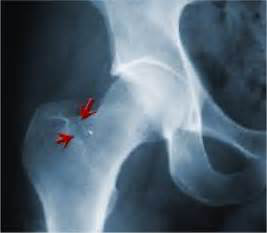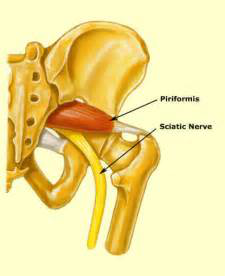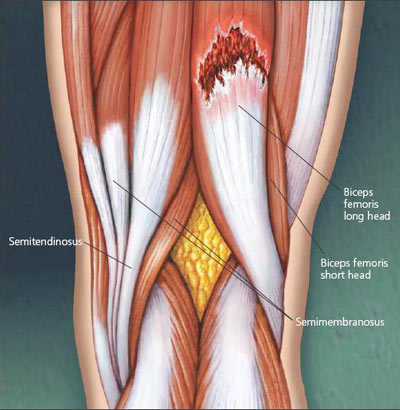Stress Fracture of the Femoral Neck
 This is a partial fracture or crack at the top of the femur bone in the hip where it attaches to the pelvis. Stress fractures result from imbalances between the bone formation and bone resorption. When bones are put under excessive stress, such as during weight-bearing exercise, they respond by increasing the rate of new bone growth. If this growth does not equal the rate of bone resorption then a stress fracture is likely to occur. A patient suffering this presentation will generally report that they are feeling a dull ache in the groin or deep in the hip. The onset of this pain is generally gradual over a period of weeks or months but can be acute in rare cases. It is commonly made worse by exercise, but it may also be reported as being felt during walking, rest and even at night. This type of condition will not result in long term effects as long as it is appropriately treated and excessive pressure is not applied to the area during the recovery period. Physiotherapy treatment is dependent on the rate and degree of the stress fracture. Treatment commonly involves providing crutches and education regarding the use of crutches in the beginning, and once healing has occurred it involves releasing tight structures, stretching, and strength training.
This is a partial fracture or crack at the top of the femur bone in the hip where it attaches to the pelvis. Stress fractures result from imbalances between the bone formation and bone resorption. When bones are put under excessive stress, such as during weight-bearing exercise, they respond by increasing the rate of new bone growth. If this growth does not equal the rate of bone resorption then a stress fracture is likely to occur. A patient suffering this presentation will generally report that they are feeling a dull ache in the groin or deep in the hip. The onset of this pain is generally gradual over a period of weeks or months but can be acute in rare cases. It is commonly made worse by exercise, but it may also be reported as being felt during walking, rest and even at night. This type of condition will not result in long term effects as long as it is appropriately treated and excessive pressure is not applied to the area during the recovery period. Physiotherapy treatment is dependent on the rate and degree of the stress fracture. Treatment commonly involves providing crutches and education regarding the use of crutches in the beginning, and once healing has occurred it involves releasing tight structures, stretching, and strength training.

Piriformis Syndrome
The piriformis is a small muscle that is situated deep in the buttock region. It originates from the sacrum and attaches to the top of the femur. Piriformis conditions are commonly thought of as buttock pain and can result on nerve symptoms down the leg. Piriformis conditions are caused by the tightening of the piriformis muscle. This may due to a previous strain in the muscle or repetitive microtrauma to the muscle. Microtrauma is microscopic damage that occurs within the muscle, which does not usually produce any symptoms such as pain unless this occurs repetitively. This in turn leads to progressive tightening and thickening of the muscle. Stretching this tight muscle during movement then causes pain. Patients with this syndrome will also likely have an accompanying gluteus medius weakness that will need to be addressed. Piriformis conditions produce pain that is felt deep in the buttock. This pain is mainly felt during hip movement or during movements of high stretch. Physiotherapy treatment will likely involve activity modification, soft tissue massage, muscle releases, stretching, taping and electrotherapy treatment. During rehabilitation, a progressive strength and muscle control/coordination program will also be provided. Recovery usually takes a number of days to weeks.

Hamstring Strain
A hamstring muscle strain refers to a tear in one of the hamstring muscles. A hamstring muscle strain occurs when the muscle is contracted under excessive force while in a stretched position. This commonly occurs during the starting or stopping phase of running or sprinting just before or after the foot hits the ground. The first sensation commonly reported is sudden pain in the back of the thigh, due to damage to the muscle fibres, and some people report feeling a tearing sensation. If you have a minor strain, you may be able to continue active participation with minimal restriction; however, the pain may increase significantly as the muscle cools down following activity. At this stage, patients often report progressive tightening of the muscle and stiffening of the hip and knee. In severe cases, patients are unable to continue sporting participation and may even have difficulty walking due to excessive pain in the thigh, muscle tightness, weakness and spasm. These severe cases are also accompanied by visible swelling of the muscle. To limit severity of this injury, you should cease exercise and seek medical treatment from your physiotherapist. The most important phase in the treatment of an injury is the first 24– 48 hours. Swelling is a necessary step of the healing process but must be controlled to avoid further injury. Patients should follow the RICE (Rest, Ice, Compression and Elevation) during this period of time. If the pain and discomfort is still present after 48 hours, make an appointment with your physiotherapist. Most hamstring muscle strains will heal within a number of weeks, but a proportion of injuries can result in longer-term effects, depending on the degree of damage and lack of appropriate early management. Injury to surrounding structures may delay return to normal activity or result in tight and weakened hamstring muscles and increase the likelihood of reinjury to the area. Physiotherapy treatment will initially involve decreasing pain and swelling and promoting healing. This includes electrotherapy, soft tissue massage, stretching and kinesiotaping. As treatment progresses, it will involve progression of the stretching program and implementation of a strength training program.
